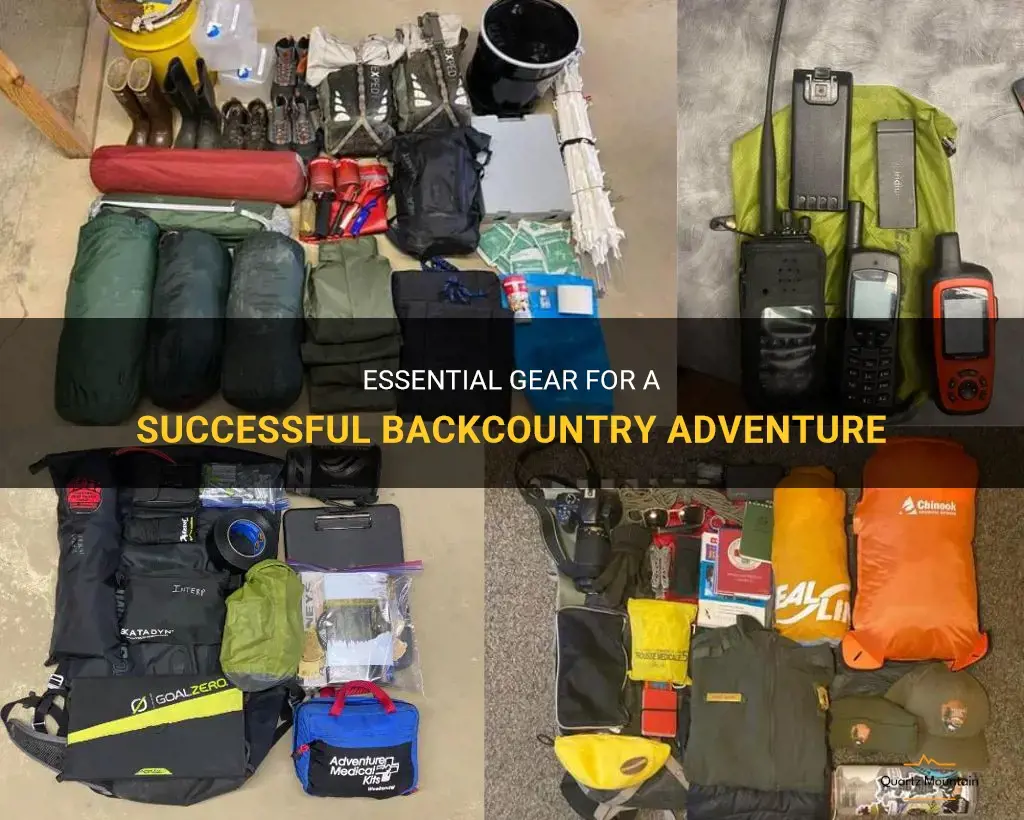
Are you planning a thrilling backcountry adventure? Whether you're venturing into the wilderness on foot, by bike, or on skis, having the right gear is crucial for a successful and safe experience. From essential navigation tools to reliable shelter and emergency equipment, this guide will highlight the must-have gear for a memorable backcountry adventure. So, grab your backpack and get ready to gear up for an unforgettable journey off the beaten path.
| Characteristics | Values |
|---|---|
| Clothing | Quick-drying, lightweight, moisture-wicking |
| Footwear | Sturdy, waterproof, supportive |
| Shelter | Lightweight, durable, waterproof |
| Sleeping bag | Compact, lightweight, temperature-rated |
| Backpack | Comfortable, adjustable, durable |
| Food | Lightweight, high-calorie, non-perishable |
| Water | Filter or purification system, lightweight containers |
| Navigation | Map, compass, GPS |
| First aid kit | Essential medical supplies, medications |
| Fire starter | Matches, lighter, fire starter |
| Tools | Knife, multi-tool, repair kit |
| Lighting | Headlamp, spare batteries |
| Communication | Cell phone, satellite phone, GPS beacon |
| Personal items | Toiletries, sunscreen, bug spray, toilet paper |
| Emergency | Whistle, signal mirror, emergency blanket |
| Entertainment | Book, playing cards, camping games |
What You'll Learn
- What are the essential items to pack for a backcountry hiking trip?
- How should I plan my meals and what food should I pack for a backcountry camping trip?
- What type of clothing and gear should I pack for different weather conditions in the backcountry?
- Are there any specific safety items or equipment that I should bring on a backcountry adventure?
- How should I plan for water and hydration during a backcountry trip, and what items should I pack to ensure I have enough water?

What are the essential items to pack for a backcountry hiking trip?
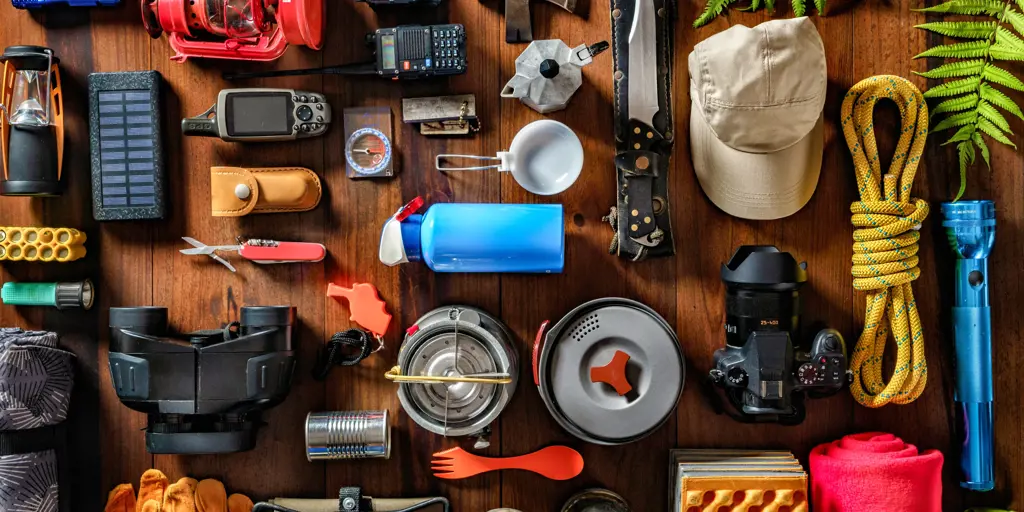
When preparing for a backcountry hiking trip, it is crucial to pack the right gear and essentials to ensure a safe and enjoyable experience. The backcountry often presents challenges such as rugged terrain, unpredictable weather, and limited resources, making it essential to be prepared. Here are some essential items that should be included in your backpack when planning a backcountry hiking trip:
- Map and Compass: A detailed map and a reliable compass are essential tools for navigation. Even if you have a GPS device, it is important to have a backup in case the batteries run out or the device malfunctions. Familiarize yourself with the map and ensure you know how to use a compass before embarking on your trip.
- First Aid Kit: Accidents can happen in the backcountry, so carrying a well-stocked first aid kit is crucial. Include items such as bandages, antiseptic wipes, pain relievers, blister pads, and any necessary prescription medications. It is also advisable to have knowledge of basic first aid procedures.
- Shelter: Having a lightweight and compact shelter, such as a tent or tarp, is essential for protection against the elements. Select a shelter that is suitable for the expected weather conditions and practice setting it up before your trip to ensure efficiency.
- Sleeping Bag and Sleeping Pad: A warm and comfortable sleeping bag and sleeping pad are essential for a good night's sleep in the wilderness. Choose a sleeping bag that is appropriate for the expected temperature range, and opt for a sleeping pad that provides insulation and cushioning to enhance comfort.
- Food and Water: Pack enough food to sustain you for the duration of your trip, considering the number of days and the physical demands of the hike. Choose lightweight, nutritious, and easy-to-prepare meals, such as freeze-dried options. Also, carry a water filtration system or purification tablets to ensure a safe drinking water source.
- Clothing: Layered clothing is essential to manage body temperature in varying weather conditions. Pack lightweight and moisture-wicking base layers, insulating layers, and a waterproof outer shell. Also, include extra socks, a hat, and gloves to protect against hypothermia.
- Cooking Equipment: A lightweight stove and cookware are necessary for preparing meals in the backcountry. Opt for compact and efficient cooking equipment, such as a backpacking stove and a small pot or pan. Don't forget to bring utensils, a mug, and a water bottle.
- Backpack: Choose a backpack that is suited to your trip's duration and the weight you plan to carry. It should have a comfortable and adjustable harness system to distribute weight evenly and reduce strain on your shoulders and back.
- Navigation and Communication Devices: While a map and compass are essential, carrying additional navigation and communication devices can enhance safety. Consider bringing a GPS device, a personal locator beacon (PLB), or a satellite phone for emergency situations.
- Personal Hygiene and Sanitation Items: Proper hygiene is essential, even in the backcountry. Pack items such as toilet paper, hand sanitizer, biodegradable soap, a towel, and a toothbrush to maintain cleanliness.
Remember to check the weather forecast and research the trail conditions before your trip. Also, consider bringing additional items such as a headlamp, insect repellent, sunscreen, and a repair kit for your gear. By packing these essential items and being well-prepared, you can have a safe and enjoyable backcountry hiking experience.
Essential Items to Pack for a Memorable Sleepover Experience
You may want to see also

How should I plan my meals and what food should I pack for a backcountry camping trip?
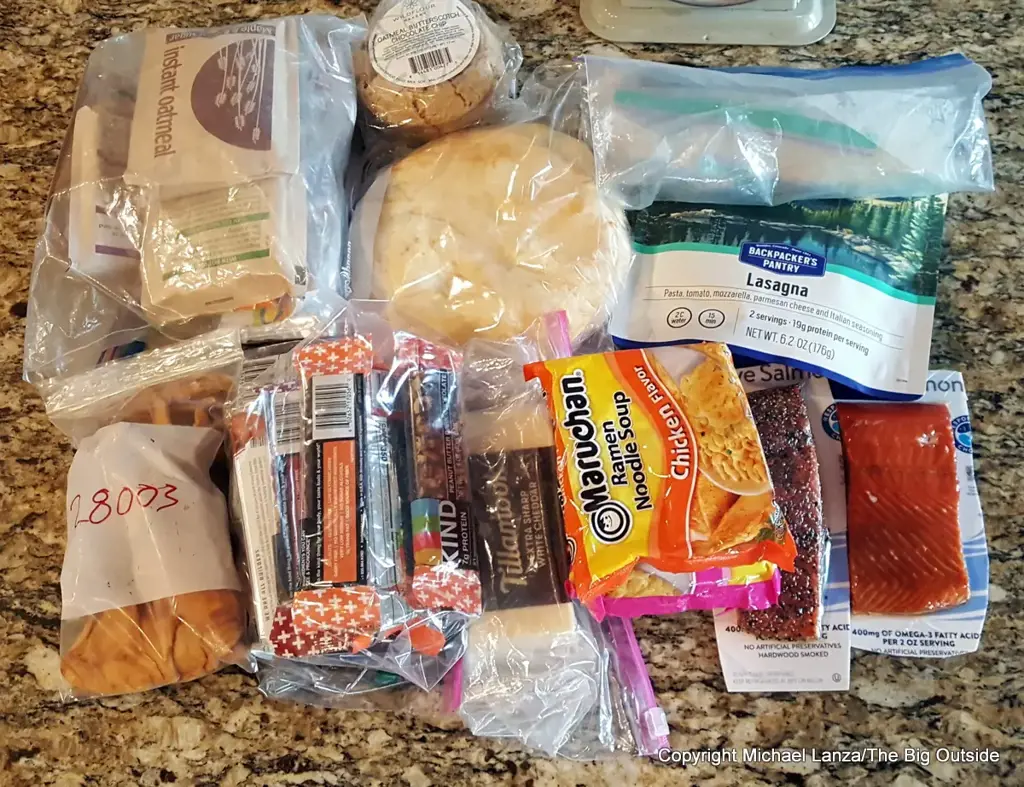
Planning your meals and packing the right food for a backcountry camping trip is essential for a successful and enjoyable experience. When camping in the wilderness, you need to consider factors such as weight, shelf stability, nutritional value, and ease of preparation. Here are some tips on how to plan your meals and what food to pack for your backcountry camping trip.
- Determine the length of your trip: The duration of your trip will determine the amount of food you need to pack. Calculate the number of meals and snacks you will need for each day.
- Consider the weight: Every ounce counts when you are carrying your food on your back. Opt for lightweight and compact foods that won't add unnecessary weight to your backpack.
- Focus on shelf-stable foods: Since refrigeration is not an option in the backcountry, choose foods that don't require refrigeration and have a longer shelf life. Some examples include dehydrated meals, freeze-dried fruits and vegetables, nuts, dried meats, and powdered milk.
- Include a variety of nutrients: It's important to eat a balanced diet even when camping. Pack foods that provide a good mix of carbohydrates, proteins, and fats. Carbohydrates will give you energy, proteins will aid in muscle recovery, and fats will provide long-lasting fuel.
- Pack foods that are easy to prepare: Keep in mind that you will have limited cooking facilities in the backcountry. Choose foods that can be prepared quickly and easily, preferably with just boiling water. Instant oatmeal, ramen noodles, couscous, and instant coffee are all good options.
- Don't forget the snacks: In addition to your main meals, pack plenty of snacks to keep you fueled throughout the day. Trail mix, energy bars, beef jerky, and dried fruits are all great choices.
- Consider dietary restrictions: If you have any dietary restrictions or food allergies, make sure to pack food that fits your needs. There are plenty of options available for vegetarian, vegan, gluten-free, and other special diets.
- Plan for water access: Water is crucial for staying hydrated, cooking, and cleaning. Make sure you have a reliable water purification system and plan your meals accordingly. Avoid packing foods that require a lot of water for cooking or rehydration.
- Think about waste management: Leave-no-trace camping principles emphasize minimizing the impact on the environment. Pack foods that produce minimal waste and consider repackaging your food into reusable containers or ziplock bags.
- Practice your meal plan at home: Before heading out on your trip, try out your meal plan at home. This will give you an idea of portion sizes, cooking times, and overall taste. It will also help you identify any foods that you may not enjoy or tolerate well.
Here is an example of a sample meal plan for a three-day backcountry camping trip:
Day 1:
- Breakfast: Instant oatmeal with freeze-dried strawberries and almonds.
- Lunch: Tortilla wraps with peanut butter, dried banana slices, and beef jerky.
- Dinner: Dehydrated chili with instant rice and a side of dried fruit.
- Snacks: Trail mix, energy bars, and dried mango.
Day 2:
- Breakfast: Instant coffee, instant eggs, and bacon bits.
- Lunch: Hummus, pita bread, and dried vegetables.
- Dinner: Pasta with dehydrated marinara sauce and parmesan cheese, accompanied by a side of nuts.
- Snacks: Granola bars, beef jerky, and dried cranberries.
Day 3:
- Breakfast: Instant pancakes with maple syrup and powdered milk.
- Lunch: Instant soup with crackers and dried apple slices.
- Dinner: Couscous with dehydrated vegetables and canned tuna.
- Snacks: Trail mix, energy bars, and dried apricots.
Remember to adjust the portion sizes and meal plan according to your own needs and preferences. With proper planning and the right food choices, you can enjoy delicious and nutritious meals even in the wilderness.
What to Pack for a Relaxing Vacation in Bora Bora
You may want to see also

What type of clothing and gear should I pack for different weather conditions in the backcountry?
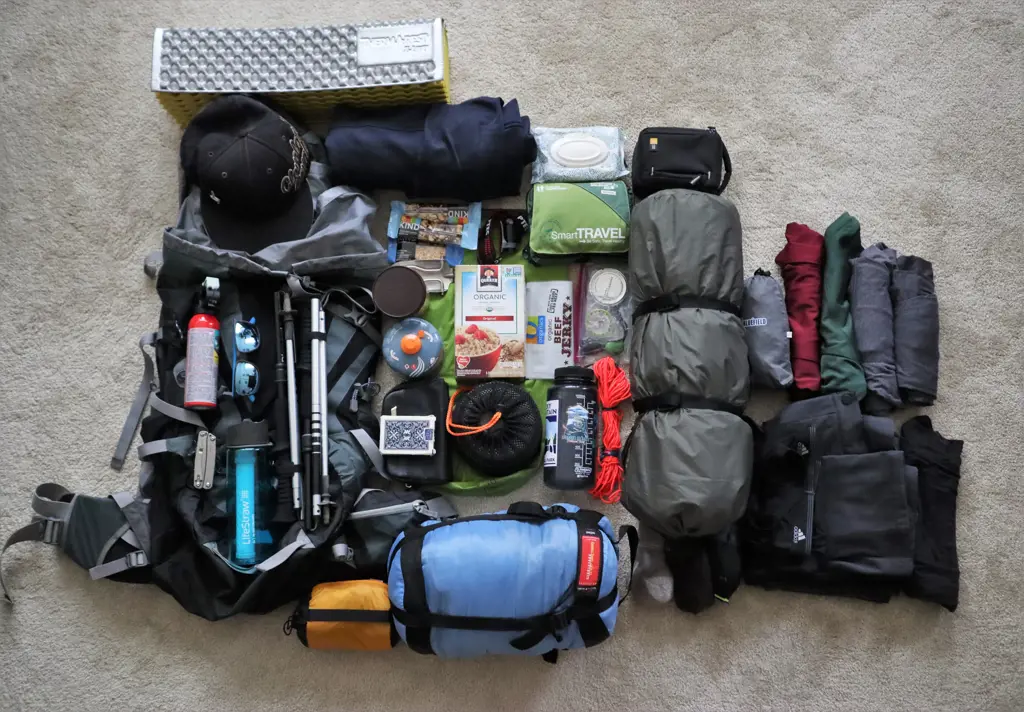
When venturing into the backcountry, it is crucial to pack the right clothing and gear to ensure your safety and comfort, especially when it comes to dealing with different weather conditions. Depending on the climate and season, the weather in the backcountry can vary greatly, so it is essential to come prepared. Here are some tips on what type of clothing and gear you should pack for different weather conditions in the backcountry.
Hot and Sunny Weather:
When hiking in hot and sunny weather, it is important to protect your skin from the sun's harmful rays. A wide-brimmed hat, sunglasses, and sunscreen with a high SPF are a must. Lightweight and breathable clothing made from moisture-wicking materials, such as nylon or polyester, will help keep you cool and dry. Opt for light-colored clothing to reflect the sun's rays rather than absorbing them. Don't forget to bring a sufficient amount of water to stay hydrated throughout your hike.
Cold and Snowy Weather:
In cold and snowy conditions, layering is the key to keeping warm. Start with a moisture-wicking base layer made of merino wool or synthetic materials to keep sweat away from your body. A mid-layer made of fleece or down provides insulation and traps warmth. Finally, a waterproof and windproof outer layer, such as a hardshell jacket and pants, will protect you from the elements. Don't forget to wear a warm hat, gloves, and insulated boots to keep your extremities warm. Pack extra pairs of socks and consider using gaiters to keep snow out of your boots.
Rainy and Wet Weather:
When hiking in rainy and wet conditions, waterproof and breathable clothing is essential. Invest in a good quality rain jacket and pants with sealed seams to keep moisture out. Consider wearing a lightweight and quick-drying base layer to stay comfortable even if you get wet. It is also important to protect your gear from getting wet, so make sure to pack your items in waterproof dry bags or stuff sacks. Don't forget to bring a pack cover to keep your backpack dry.
Variable Weather:
If you are hiking in an area with variable weather conditions, it is crucial to be prepared for anything. Layering is still important, but make sure to choose clothing that can adapt to changing temperatures. Pack a waterproof and windproof shell that can be worn over your layers. Additionally, bring extra clothing options that can be added or removed as needed, such as a lightweight down jacket or a fleece vest. Consider carrying an extra pair of shoes or boots in case your footwear gets wet.
Ultimately, the key to packing the right clothing and gear for different weather conditions in the backcountry is to plan ahead and consider the potential challenges you might face. Research the climate and weather patterns of the area you will be hiking in and choose clothing and gear that will provide the necessary protection and comfort. Additionally, always check the weather forecast before heading out and be prepared to adjust your plans accordingly. By taking these steps, you can ensure a safe and enjoyable backcountry experience regardless of the weather conditions.
Essential Items to Pack for a Successful Model Photo Shoot
You may want to see also

Are there any specific safety items or equipment that I should bring on a backcountry adventure?
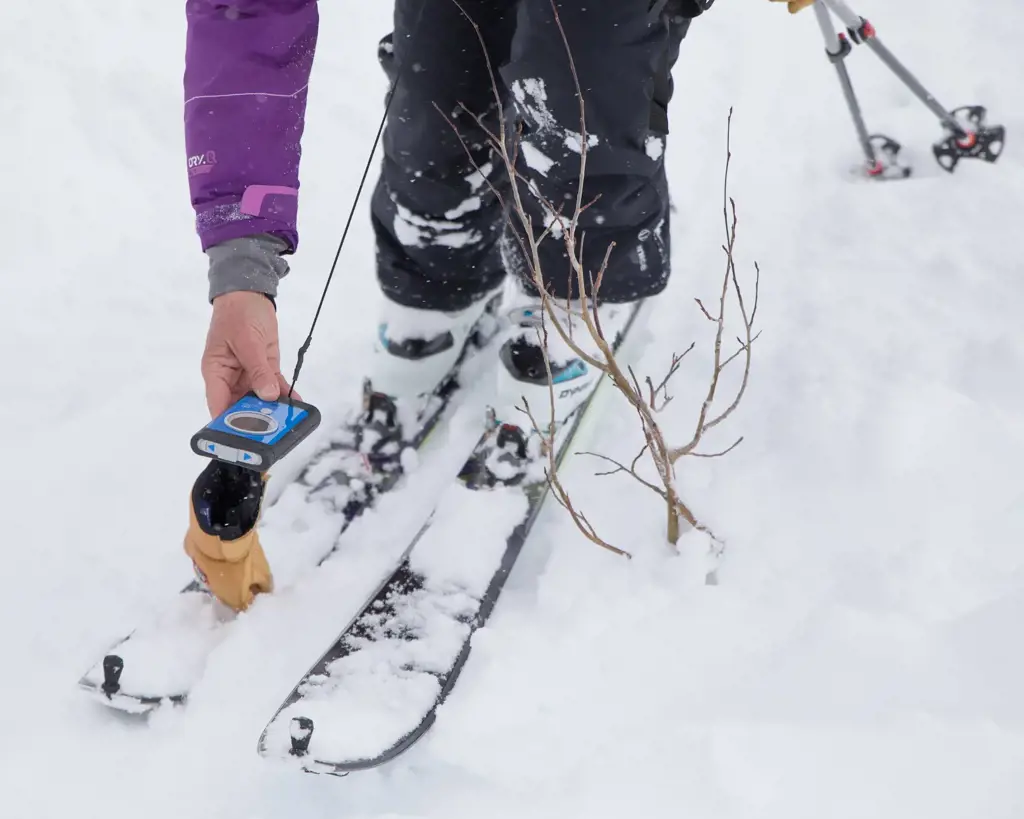
When embarking on a backcountry adventure, it is crucial to prioritize safety and be prepared for any potential risks or emergencies. Below is a list of essential safety items and equipment to consider bringing with you on your backcountry trip.
- Navigation Tools: A map and compass are essential for orienteering and route planning. It is also recommended to have a GPS device as a backup. Familiarize yourself with the area before your trip, and make sure you know how to use these tools effectively.
- First Aid Kit: A well-stocked first aid kit is a must-have for any outdoor adventure. It should include bandages, antiseptic ointment, pain relievers, tweezers, adhesive tape, and other items necessary for treating minor injuries. Additionally, include any personal medication you may need.
- Emergency Shelter: Carry a lightweight emergency shelter, such as a tarp or bivy sack, to protect yourself from unexpected weather changes or if you get lost or injured. It should be easy to set up and provide adequate protection from rain, wind, and cold temperatures.
- Communication Devices: Depending on the remoteness of your backcountry location, consider bringing a satellite phone or a personal locator beacon (PLB). These devices can be lifesaving in case of an emergency when traditional cell phone signals are not available.
- Fire Starters: Bringing several fire-starting tools, such as waterproof matches, lighters, and fire starters, is essential for warmth, cooking, and signaling for help if needed. Make sure to familiarize yourself with local regulations regarding campfires and be mindful of fire safety.
- Personal Protection: Carry personal protection items like bug spray, bear spray, and a whistle. In backcountry areas, encounters with wildlife can occur, and it is important to be prepared to protect both yourself and the wildlife.
- Extra Clothing: Even in warm weather, pack extra clothing layers to protect yourself from unexpected cold temperatures. Include a waterproof and windproof jacket, a hat, gloves, and extra socks. These items are crucial for preventing hypothermia.
- Water Filter: Drinking water from natural sources can pose health risks. A portable water filter or water purification tablets can help ensure you have access to safe drinking water. Research the water sources in the area you are visiting and plan accordingly.
- Survival Tools: Essential survival tools include a knife, multi-tool, flashlight, and extra batteries. These tools can assist in various tasks such as cutting, repairing gear, and providing light during emergencies.
- Food and Emergency Rations: Pack enough food for the duration of your trip, plus emergency rations in case of an unexpected delay. Choose lightweight, high-energy foods that can sustain you during strenuous activities.
Remember, this is not an exhaustive list, and the specific items you need may vary depending on your destination, climate, and personal preferences. It is crucial to research and assess the potential risks of your chosen backcountry adventure and pack accordingly. Always prioritize safety and ensure you have the necessary knowledge and skills to handle emergencies that may arise.
The Perfect Packing Guide for 68 Degree Weather
You may want to see also

How should I plan for water and hydration during a backcountry trip, and what items should I pack to ensure I have enough water?
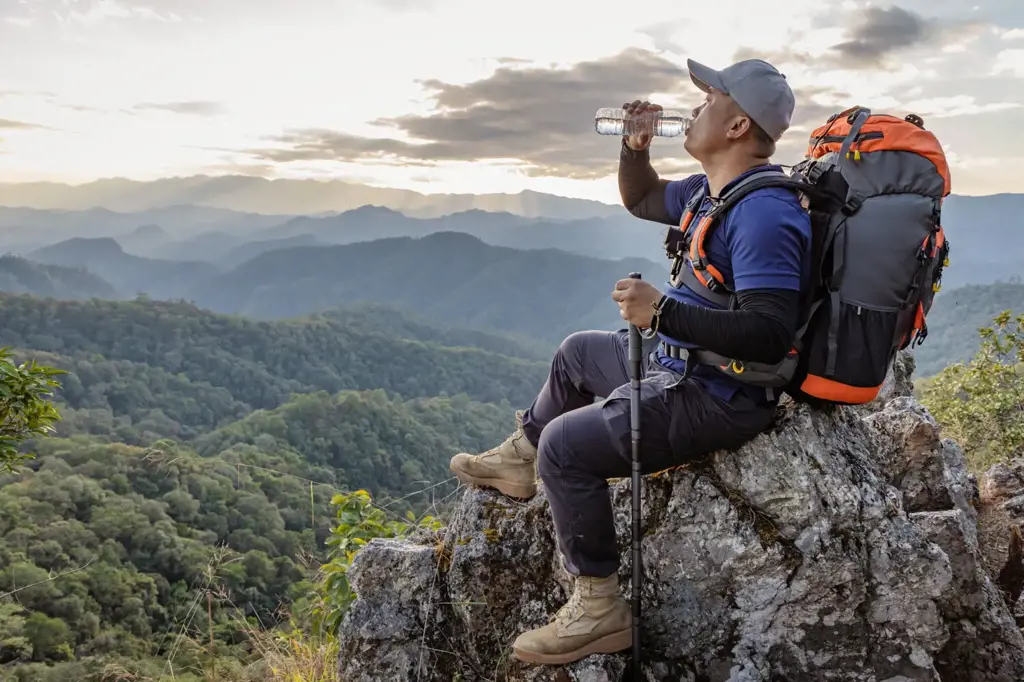
When planning a backcountry trip, water and hydration should be a top priority. Proper hydration is essential for maintaining energy levels, preventing dehydration, and avoiding heat-related illnesses. To ensure you have enough water during your trip, it is important to plan ahead and pack the necessary items.
Here are the steps you can follow to plan for water and hydration during your backcountry trip:
- Determine your water needs: The first step in planning for water is to determine how much water you will need each day. The general recommendation is to drink at least 2 liters (or about 8 cups) of water per day in moderate conditions. However, this amount can vary depending on factors such as temperature, altitude, exertion level, and individual needs. Consider these factors and adjust your water needs accordingly.
- Research water sources: Before embarking on your trip, research the available water sources along your route. This can include rivers, streams, lakes, or natural springs. Identify potential water sources and plan your daily route accordingly. It is important to note that not all water sources are safe for drinking, so make sure to research and filter or treat the water when necessary.
- Pack water containers: Once you have determined your water needs and researched water sources, it is time to pack the necessary water containers. Ensure you have enough containers to hold the required amount of water for each day. Consider using lightweight, durable containers such as collapsible water bottles or hydration bladders that can be easily carried in your backpack.
- Water filtration or treatment system: In remote backcountry areas, water sources may be contaminated with bacteria, viruses, or parasites. To ensure the water is safe to drink, it is crucial to have a reliable water filtration or treatment system. There are various options available, including water filters, purifiers, and chemical treatments such as iodine or chlorine tablets. Research and choose a system that best suits your needs and preferences.
- Plan for water resupply: Depending on the length of your backcountry trip, it may not be feasible to carry all the required water for the entire duration. In such cases, you will need to plan for water resupply along the way. This can include restocking water at designated areas or carrying a portable water filter to treat water from natural sources. Research the availability of water resupply points or potential water sources along your route to ensure you have enough water for the duration of your trip.
- Monitor water intake: During your backcountry trip, it is vital to monitor your water intake to ensure you stay adequately hydrated. Pay attention to your thirst levels and urine color, as these are indicators of your hydration status. Urine should be light yellow or clear, indicating proper hydration. If urine is dark yellow or amber, it is a sign of dehydration, and you should increase your water intake.
In addition to the above steps, it is important to be prepared for unexpected situations. Carry a backup water treatment method in case your primary system fails, and always have a contingency plan for water resupply in case your planned sources are unreliable or inaccessible.
By following these steps and packing the necessary items, you can plan for water and hydration during your backcountry trip effectively. Staying properly hydrated will contribute to your overall safety, well-being, and enjoyment of the wilderness experience.
Essential Items for Attending a Korean Wedding: What to Pack
You may want to see also
Frequently asked questions
When packing for a backcountry trip, it is important to prioritize essential items that will help ensure your safety and comfort. Some key items to include are a map, compass, and GPS device for navigation, a first aid kit for medical emergencies, a reliable sleeping bag and tent for shelter, a water filter or purification tablets for clean drinking water, a stove and cookware for preparing meals, high-calorie food that is lightweight and easy to pack, appropriate clothing layers for varying weather conditions, a headlamp and extra batteries for nighttime visibility, a multipurpose tool or knife, and extra fuel for your stove. These items will help you navigate, stay nourished, and take care of yourself while in the backcountry.
Proper packing of your backpack is crucial to ensure comfort and balance while hiking in the backcountry. Start by organizing your gear into categories such as sleeping equipment, cooking supplies, clothing, and personal items. Place heavy items close to your back and towards the middle of the pack to distribute weight evenly. Pack lighter items towards the top and outside of the pack. Utilize compression straps or stuff sacks to maximize space and keep items secure. It is also important to pack items you may need throughout the day, such as snacks, a water bottle, and rain gear, in easily accessible pockets or compartments. Finally, make sure to adjust the straps and hip belt of your backpack to ensure a proper fit and distribute weight onto your hips rather than your shoulders.
There are several common mistakes to avoid when packing for a backcountry trip. One mistake is overpacking and bringing unnecessary items that will only add weight and take up valuable space in your backpack. It's important to pack light and only bring what you truly need. Another mistake is not properly testing and familiarizing yourself with your gear before heading into the backcountry. Make sure to set up your tent, try out your stove, and check that all equipment is functioning properly before your trip. Additionally, forgetting crucial items such as a map, compass, or first aid kit can be a serious oversight. Always double-check your gear list and ensure you have all essential items before leaving for your trip. Finally, wearing inappropriate clothing for the weather conditions can also be a mistake. Always check the forecast and pack appropriate layers to stay comfortable and safe in varying conditions.



















